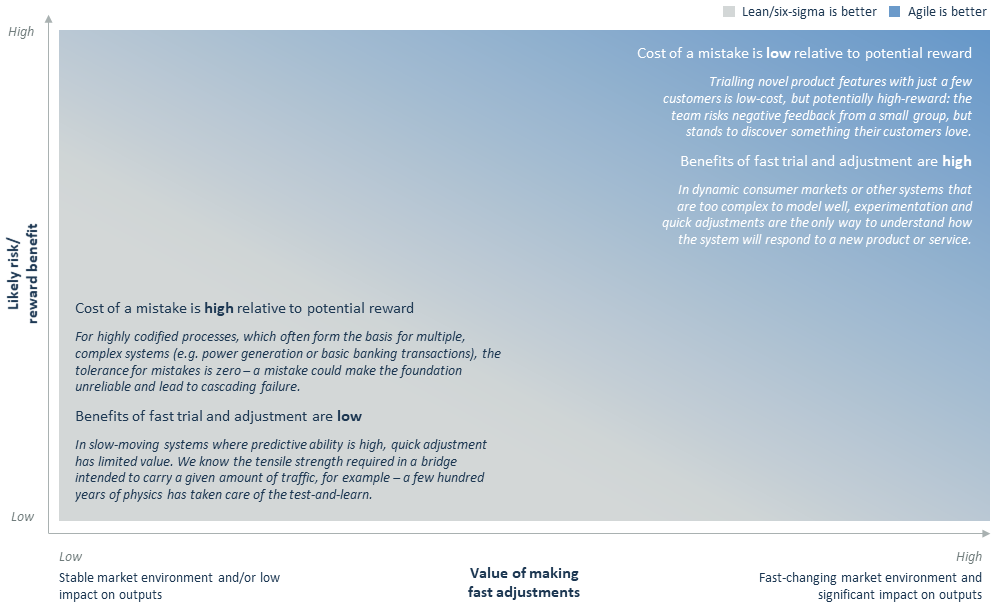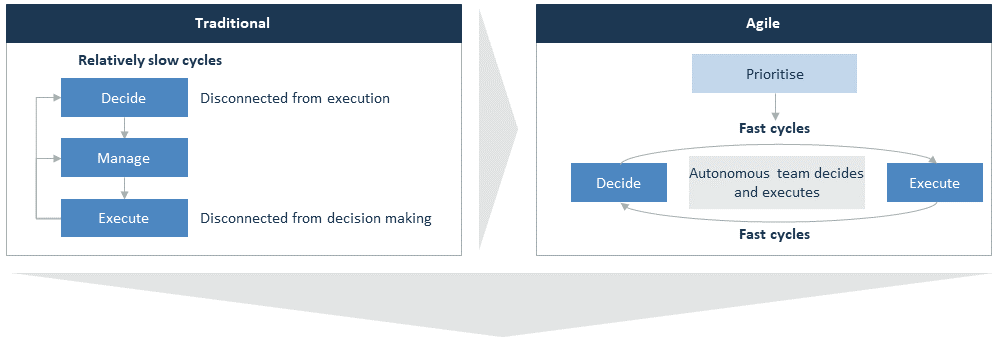Even before the pandemic, we often saw ‘Agile’ touted as the cure for every business woe. As the disruption wrought by COVID-19 increases uncertainty and the pace of change across industries, agility has become even more desirable as a business capability. Every leader wants to feel that their organisation can respond quickly as the market shifts, and it’s true that agile ways of working, implemented well, can help build that capability.
The irony we have noticed with ‘Agile’ implementations is that often, they don’t deliver agility – or any of the other promised benefits. Instead, misapplication can create a distraction from what matters, undermining effective processes, and blurring accountabilities – in turn slowing down teams that were already working well, and potentially increasing risk1.

In this article, we explain why there’s no ‘one size fits all’ approach to getting the most out of agile ways of working in large organisations. Instead, it’s critical to identify which parts of your organisation are most likely to benefit from the approach, take a tailored approach to setting those teams up for success, and build in accountability for delivery. The focus throughout needs to be on the conversations and behaviours that improve performance, not the artefacts that get all the attention in the press.
#1: Not everyone means the same thing by ‘Agile’
#2: Agile ways of working aren’t useful for every team
#3: Truly agile teams need empowerment, not buzzwords
#4: Your leadership approach will need to change
#5: More autonomy doesn’t mean less accountability
One of the challenges with agile ways of working is that while everyone understands the word agile, there is no guarantee that any two people will understand the same thing by it. It’s useful to be precise, though: it accelerates alignment and focus.
Originating in 2001 out of frustration experienced by enterprise software developers, the term was intended to capture a fundamentally different way of working from the approach that was standard at the time. Rather than attempting to document every user requirement, plan the project to the last work-hour and spend years working in rigid silos before delivering a usable output, the authors of the Agile Manifesto2 proposed a much more iterative approach.
It’s an approach that empowers cross-functional teams to progressively improve customer outcomes, by frequently seeking and quickly responding to important new information to deliver something of value to the customer – who could be internal or external to the organisation – over short timeframes.
As the agile approach has grown from a first-principles idea into the multi-billion-dollar ‘Agile’ industry, the term has also come to mean a collection of methods intended to operationalise the agile approach, characterised by small, self-directing teams who work in rapid iteration cycles.
We’ve found it’s useful to get the approach clear first, and then choose the methods that best support it, given the unique business context. We’ve seen genuinely agile organisations that use no ‘Agile’ terminology; and increasingly, we’re seeing organisations with plenty of terminology, but no appreciable agility.
A specialist in financial services begins a scoping meeting with a new senior team looking to tighten their data management practices. As the meeting kicks off, a late arrival sweeps in, introduces herself as “the Agile coach”, and begins writing up actions on post-it notes. The rest of the participants, who already have a clear agenda and a designated note-taker capturing key discussion points and agreed actions, are initially perplexed, but then get on with the meeting. The Agile coach is left with a pile of post-its that no-one has any use for.
Stories like this are becoming common in large organisations: agile ways of working have been applied indiscriminately, wasting time and creating distraction. Many leaders we’ve spoken with have an instinctive feeling for where agile ways of working are likely to be useful for them, but struggle to articulate objective boundaries that help to focus the effort (and counter evangelists). We’ve found it’s useful to think about the work done in an organisation along two dimensions.

Agile ways of working are best suited – in fact, required – at the top right of this map, while at the bottom left they add no value. There is little reward for the kind of risks that teams can realistically take, and the systems they operate in are relatively stable and predictable. In fact, in this space, agile methods may increase risk by undermining established operating protocols.
These two extremes shouldn’t be contentious: agile ways of working don’t create value for a production line or a power generator beyond what an effective Continuous Improvement programme should already be delivering. The challenge for leaders seeking agility arises in the wide zone between the two extremes. We’ve found that a tailored approach, anchored in the unique problems and opportunities the organisation is facing – both its risk and reward profile and the potential value of very fast adjustment – is the best way to ensure the agile approach delivers value.
A network innovation team, broadly tasked with improving customer experience, has a long list of potential new technologies to test. The team selects one option and undertakes a two-week sprint, testing the new technology with customers from a high-priority segment. Their customers don’t notice any meaningful difference, compared with technology currently in use, and the team now believes there are better options on their list. When the team proposes deprioritising the new technology for the quarter, a senior leader asks them to find another way to demonstrate customer value, as the investment decision has already been made.
Even when teams apply agile ways of working in areas that seem well placed to benefit from the approach, leaders need to be wary of AINO – ‘Agile In Name Only’. Here, the team was using agile tools and methods, but the core principle of empowering them to progressively improve customer outcomes was missing.
Building empowerment, particularly in an organisation that has traditionally worked in a top-down manner, requires actively creating three critical elements:
In this example, none of these elements were in place. The investment decision was a bigger bet than this team could make, with implications well beyond the very loosely defined “customer experience improvements” the team was trying to achieve in the short term.
Although trained in agile methods, the team wasn’t set up for success. We have found that working from first principles with each team helps to mitigate the risk of AINO. Supporting each team to agree on the measurable outcomes they will achieve and to develop their own agile working principles, then enables them both to choose the best methods and tools for now and to adjust over time as circumstances change. They understand the why, not just the what and how, which means they can also quickly identify when they’ve been asked to work on the wrong thing – not everything will be an agile nail to hit with the agile hammer.
Our client regularly identified innovative improvement ideas and customer experiences but struggled to implement them quickly. They had experimented with new ways of working, including ‘Agile’ and Human-Centred Design, but were encountering challenges with teams using different methods and terminologies, making it difficult to achieve the desired velocity.
The innovation team example above also illustrates the mindset and skills shift that leaders need to make to get value out of agile ways of working. Choosing priority outcomes for agile teams, defining boundaries for decision-making, securing the right resourcing and clearing barriers become the critical jobs for a leader. This contrasts with more traditional tasks like top-down decision-making and direct KPI management. In other words, the agile approach shifts the emphasis strongly from management tasks towards leadership tasks.
Day-to-day leadership behaviour must also create and continuously support an environment that fosters experimentation, learning and self-management. Leaders will need to encourage team members to hold each other to account for what they’ve committed to contribute to the team’s objectives, significantly reducing the leader’s own role in actively managing performance.


Even organisations that were ‘born digital’ find they need to create hybrid operating and organisational models as they grow3, introducing the need to manage interfaces between agile and more traditional teams. While appropriately resourced and empowered agile teams may choose how they work across these interfaces, this autonomy must come with accountability for delivering results4. The executive team needs to make performance commitments to investors, which agile teams then need to sign up to and deliver against, often without being able to describe exactly how they will do so.
We’ve observed that reliable delivery only happens when accountability is built into the operating model. It must be clear who’s on the hook for concrete, measurable outcomes that link directly to business value. In practice, this works best if accountability for delivery rests with a critical role in each team: the product owner.
A great product owner drives outcomes across two spheres – agile and traditional – bridging the gap between day-to-day team delivery and the longer cycle of more traditional performance metrics. They are not project managers or team leaders in the usual sense; they are excellent problem-solvers, influencers and networkers, tenacious in creatively pursuing the target outcome and they consistently link customer outcomes back to operational and financial measures, ensuring customer value becomes business value. Developing a pool of strong product owners is critical in scaling agile ways of working in large organisations.
Our client faced a fundamental shift in their market, which radically reduced barriers to churn for their customer base. This created significant pressure to improve customer experience and to reduce cost to support more competitive pricing. We were engaged to help the team to build momentum and lift their pace of change.
If you are careful about how you apply agile ways of working, keeping the focus on value delivery and behaviour instead of buzzwords and artefacts, the approach can help your company thrive in the face of disruption and ongoing uncertainty. Success depends on applying it with the right teams, firmly anchoring implementation in core principles, and providing the right leadership with the right accountabilities. Without these disciplines, ‘Agile’ will almost certainly fail to live up to the hype.
[1] “Is the Agile Manifesto still a thing?”, Atlassian blog post (click here)
[2] The Agile Manifesto and its 12 principles (click here)
[3] “Failed #SquadGoals”, Jeremiah Lee (click here)
[4] “Balancing Autonomy with Accountability”, Edwin Dando (click here)
Click to download a printable version of this article

Director, Partners in Performance
Tom is the Managing Director of our South East Asian region and heads our Organisation Practice globally. He has over 30 years’ experience in consulting and executive line management in diverse environments across South East Asia, Australia, New Zealand, Africa, Europe and Latin America.

Partner, Partners in Performance
Helen manages our global Organisation Practice. She has close to 20 years’ experience in consulting and operations leadership roles, across industries including telco, retail, logistics, financial services and entertainment. Helen holds a PhD in Organisational Psychology and has deep expertise in building excellent organisations.
| We actively reduce the climate impact from our operations and invest in community-based climate solutions to balance remaining carbon emissions |